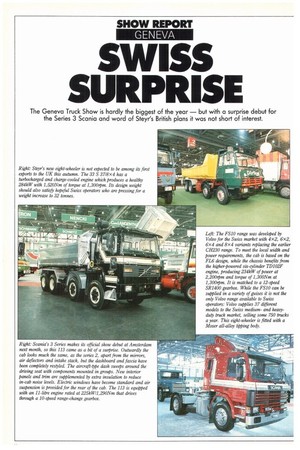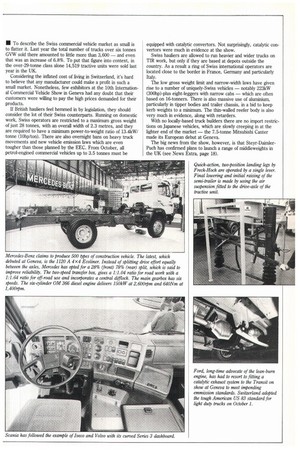SWISS SURPRISE
Page 30

Page 31

If you've noticed an error in this article please click here to report it so we can fix it.
The Geneva Truck Show is hardly the biggest of the year — but with a surprise debut for the Series 3 Scania and word of Steyris British plans it was not short of interest.
Right: Steyr's new eight-wheeler is not expected to be among its first exports to the 11K this autumn. The 33 S 3718x4 has a turbocharged and charge-cooled engine which produces a healthy 284kW with 1,520Nm of torque at 1,300rpm. Its design weight should also satisfy hopeful Swiss operators who are pressing for a weight increase to 32 tonnes.
Right: Scania's 3 Series makes its official show debut at Amsterdam next month, so this 113 came as a bit of a surprise. Outwardly the cab looks much the same, as the series 2, apart from the mirrors, air deflectors and intake stack, but the dashboard and fascia have been completely restyled. The aircraft-type dash sweeps around the driving seat with components mounted in groups. New interior panels and trim are supplemented by extra insulation to reduce in-cab noise levels. Electric windows have become standard and air suspension is provided for the rear of the cab. The 113 is equipped with an 11-litre engine rated at 225kW11,2901Vm that drives through a 10-speed range-change gearbox. • To describe the Swiss commercial vehicle market as small is to flatter it. Last year the total number of trucks over six tonnes GVW sold there amounted to little more than 3,600 — and even that was an increase of 6.8%. To put that figure into context, in the over-29-tonne class alone 14,519 tractive units were sold last year in the UK.
Considering the inflated cost of living in Switzerland, it's hard to believe that any manufacturer could make a profit in such a small market. Nonetheless, few exhibitors at the 10th International Commercial Vehicle Show in Geneva had any doubt that their customers were willing to pay the high prices demanded for their products.
If British hauliers feel hemmed in by legislation, they should consider the lot of their Swiss counterparts. Running on domestic work, Swiss operators are restricted to a maximum gross weight of just 28 tonnes, with an overall width of 2.3 metres, and they are required to have a minimum power-to-weight ratio of 13.4kW/ tonne (10hp/ton). There are also overnight bans on heavy truck movements and new vehicle emission laws which are even tougher than those planned by the EEC. From October, all petrol-engined commercial vehicles up to 3.5 tonnes must be equipped with catalytic convertors. Not surprisingly, catalytic convertors were much in evidence at the show.
Swiss hauliers are allowed to run heavier and wider trucks on TIR work, but only if they are based at depots outside the country. As a result a ring of Swiss international operators are located close to the border in France, Germany and particularly Italy.
The low gross weight limit and narrow-width laws have given rise to a number of uniquely-Swiss vehicles — notably 223kW (300hp)-plus eight-leggers with narrow cabs — which are often based on 16-tanners. There is also massive use of aluminium, particularly in tipper bodies and trailer chassis, in a bid to keep kerb weights to a minimum. The thin-walled reefer body is also very much in evidence, along with retarders.
With no locally-based truck builders there are no import restrictions on Japanese vehicles, which are slowly creeping in at the lighter end of the market — the 7.5-tonne Mitsubishi Canter made its European debut at Geneva.
The big news from the show, however, is that Steyr-DaimlerPuch has confirmed plans to launch a range of middleweights in the UK (see News Extra, page 18).




















































































































